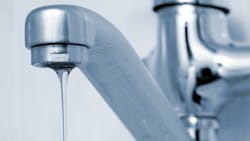High arsenic found in NYC housing complex’s water
Elevated levels of arsenic have been found in tap water at a New York City public housing complex, with resident being told not to drink or cook with the water.
According to the Environmental Working Group (EWG), the arsenic levels were found at the Jacob Riis Houses in the East Village of New York City and the problem has lasted for more than a week.
As of September 8, city officials said there were no “discernable” amounts of arsenic in the housing complex’s tap water. But people who live there are still being urged to avoid using it to drink or cook with until tests are completed.
“Almost every week a new water crisis makes headlines,” said Olga Naidenko, vice president for science investigations at EWG. “This latest situation illustrates why more than 50 percent of participants in the U.S. recently surveyed believe their drinking water is unsafe.”
The Jacob Riis Houses complex consists of 19 residential buildings with more than 3,000 residents. Water tests found levels of arsenic, a heavy metal, between 12 and 14 parts per billion (ppb).
In 2001, the Environmental Protection Agency set a legal limit for arsenic in drinking water of 10 ppb. EWG says that a more recent EPA analysis, from a 2010 draft report, suggests that arsenic is much more toxic than previously estimated and that 10 ppb was not low enough to protect public health.
California’s Office of Environmental Health Hazard Assessment published a public health goal of 0.004 ppb, or 4 parts per trillion, of arsenic in drinking water. The goal is based on an exhaustive review of studies of the health effects of arsenic. It is the level of arsenic in drinking water that would not pose a significant human health risk.
“Arsenic is one of the most toxic substances detected in drinking water,” said Tasha Stoiber, Ph.D., a senior scientist at EWG. “For the most vulnerable residents – pregnant people, infants, and others with serious health issues – this could fast become a water emergency.”
Arsenic is a commonly detected contaminant in drinking water. Sometimes levels are higher and require treatment. It’s unclear how the Jacob Riis complex’s water became contaminated.
On September 2, the New York City Housing Authority, or NYCHA, began distributing cases of water to residents. The agency planned to provide bottled water until the water in the buildings was deemed safe to use but ran out of supplies on Monday night. The state Department of Environmental Protection opened fire hydrants and created makeshift sinks for the residents of the Jacob Riis buildings to use to fill plastic gallon jugs with water.
Four days later, N.Y.CHA announced arsenic had not been detected in the most recent water samples tested in the East Village but that further tests were needed. As a precaution, the restrictions remain on Jacob Riis tenants’ drinking and cooking with tap water.
New York City Mayor Eric Adams said the water supply for the rest of the city is safe to drink. The city’s Department of Environmental Protection found no arsenic detected in water samples from the surrounding neighborhood.
